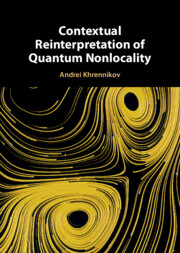Book contents
- Frontmatter
- Dedication
- Contents
- Preface
- Acknowledgments and Recollections
- 1 Introduction to Quantum Measurement Theory
- Part I Quantum Foundations
- Part II Bell Inequalities
- Part III Contextuality: Mathematical Modeling and Interpretation
- 10 Contextual Approach to Probability and Measurement
- 11 Contextual Structuring of Classical and Quantum Physics
- 12 Växjö Interpretation
- Part IV Contextual Entanglement in Quantum and Classical Physics
- Part V Hertz, Boltzmann, Schrödinger, and de Broglie on Hidden Parameters
- Part VI Further Developments
- References
- Index
11 - Contextual Structuring of Classical and Quantum Physics
from Part III - Contextuality: Mathematical Modeling and Interpretation
Published online by Cambridge University Press: 28 November 2024
- Frontmatter
- Dedication
- Contents
- Preface
- Acknowledgments and Recollections
- 1 Introduction to Quantum Measurement Theory
- Part I Quantum Foundations
- Part II Bell Inequalities
- Part III Contextuality: Mathematical Modeling and Interpretation
- 10 Contextual Approach to Probability and Measurement
- 11 Contextual Structuring of Classical and Quantum Physics
- 12 Växjö Interpretation
- Part IV Contextual Entanglement in Quantum and Classical Physics
- Part V Hertz, Boltzmann, Schrödinger, and de Broglie on Hidden Parameters
- Part VI Further Developments
- References
- Index
Summary
In this chapter the contextual measurement model (CMM) is employed forprobabilistic structuring of classical and quantum physics. We start with CMM framing of classical probability theory (Kolmogorov 1933) servingas the basis of classical statistical physics and thermodynamics. Then weconsider the von Neumann quantum measurement theory with observablesgiven by Hermitian operators and the state update of the projective typeand represent it as CMM. The quantum instrument theory is a generalizationof the von Neumann theory permitting state updates of the non-projectivetype and it also can be represented as CMM. We also show connectionof the generalized probability theory with the space of probability measureswith CMM. Finally, linear space representation for contextual probabilityspace is constructed by using the construction going back to Mackey.
Keywords
- Type
- Chapter
- Information
- Contextual Reinterpretation of Quantum Nonlocality , pp. 127 - 139Publisher: Cambridge University PressPrint publication year: 2024

